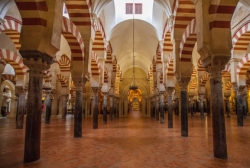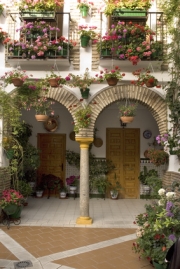Cordoba
Córdoba, the Forgotten Gem of Andalucia
If it was anywhere else in the world, Córdoba would be
recognised as a spectacular city, a potent blend of Moorish
influences and Spanish style. Instead its fate has been to languish
in third place on the podium of Andalucian treasures, overshadowed
by Seville's operatic flair and Granada's elegant Alhambra.
Speak to the locals and you might sense a little resentment that
their Córdoba can occasionally be overlooked when foreigners talk
about Andalucía, but more often a relief that their city has been
allowed to preserve its glories without having to make too many
concessions to the tourist trade.
Those visitors who make it to Córdoba, about 142km (88 miles)
north-east of Seville, return raving about its undimmed splendour.
Oppressively hot in high summer (Córdoba has the highest average
summer temperatures of any city in Europe), it is a city that is
best seen in spring or late autumn, when it's a joy to wander its
narrow Moorish streets, peering into the tiled courtyards and
flower gardens that lurk behind the gates.

The impressive Mezquita of Córdoba
A thousand years ago, Córdoba was among most populous cities in
the world, a multicultural hub of an Islamic empire stretching
across North Africa into Iberia. Even Christians in northern Europe
called it the Jewel of the World. The Moorish influence is
still the most potent style in Córdoba, exemplified by the imposing
Mezquita.
This great mosque was one of the most impressive constructions
of the Islamic empire in the west. After the Reconquista,
the Spanish, for whom architectural sensitivity was not a priority,
built a cathedral inside it, but the elegant arches of the mosque
are still the dominant motif.

Flower-filled patio in Córdoba
That Moorish splendour finds a quieter echo in the private
patios, celebrated every May in the Concurso De Patios, in
which those tiled enclaves are revealed at their floral best, in a
Spanish equivalent of an English village flower show.
Significantly, the prizes go to the patios which show the most
reverence for Córdoba's culture and tradition.
Those looking for the brisk flamboyance and lively noise of
Andalucía might be surprised by Córdoba. It's less raucous than
Seville, giving it an undeserved reputation of being haughty. The
poet Manuel Machado called it Córdoba callada - silent
Cordoba. It's hardly that; this is Andalucia after all where a
casual conversation is usually conducted in cheery shouts, but once
the day-trip coaches and tourist parties have departed, the early
evening city takes on a tranquil air.
It's a place for casual exploration in the old quarter, for
sipping a chilled sherry in one of its shadowy bars, lavishly-tiled
and refreshingly cool. When it comes to cuisine, Córdoba looks to
the coast and the mountains. It has its own variation on the
traditional Andalucian summer soup, gazpacho.
Salmorejo takes the basic recipe but makes it much
heartier by throwing in ham, eggs, and the occasional slice of
sausage. It's about the only thing in Córdoba that isn't elegantly
graceful.
Córdoba is on the AVE high-speed train network that links Madrid
with Seville and Malaga making comfortable travel from airports in
the capital or in Andalucia very easy.